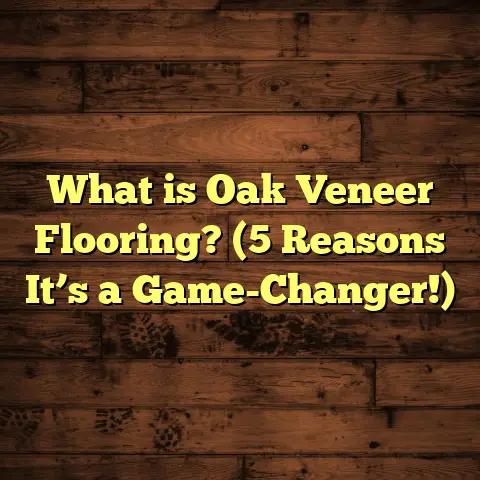What is Soft Floor Covering? (5 Types to Transform Your Space)
Timelessness is something I’ve always admired when it comes
to home design, especially flooring. Floors do more than just
support our feet—they set the tone for an entire space. Among
the many options out there, soft floor coverings stand out for
their comfort, style, and versatility. They add warmth and
texture in ways hard surfaces simply can’t match.
What Is Soft Floor Covering?
Soft floor covering refers to any type of flooring material
that has a cushioned or flexible surface. Unlike hardwood or tile,
soft flooring feels gentle underfoot and often provides extra
insulation and sound absorption. These materials include carpets,
rugs, vinyl, cork, and rubber.
The appeal of soft flooring lies in its ability to create cozy,
inviting spaces. It’s not just about aesthetics; it’s also about
function. Soft floor coverings reduce noise, offer comfort during
long periods of standing or walking, and help protect against slips
and falls. For families with kids or elderly members, this can be a
major advantage.
When I started working with flooring years ago, I used to focus
mainly on hardwood and tiles because they looked durable and stylish.
But as I gained experience, I realized soft floors do much more than
just look nice—they make your home feel like home.
Let me walk you through what soft floor coverings are all
about, their types, benefits, and how they can transform your space.
The Basics: Why Soft Floor Coverings Matter
Have you ever noticed how certain rooms just feel warmer or
more welcoming? Often, that’s because of the flooring choice. Soft floors
make a room feel more intimate and comfortable.
One of my first clients was remodeling their living room. They
wanted a warm space for family movie nights and playtime with their kids.
We installed a plush carpet with thick padding underneath. Their feedback?
They couldn’t believe how much more inviting the room felt—and how much
quieter it became.
Soft floors absorb sound waves rather than reflecting them back. That’s
why spaces with carpets or cork feel quieter than those with bare tile or wood.
Five Types of Soft Floor Coverings to Transform Your Space
Let’s explore five popular types of soft floor coverings that can change
the look and feel of your rooms—from cozy bedrooms to high-traffic areas.
1. Carpet: The Timeless Soft Floor Classic
Carpet is probably what most people think of when they hear “soft floor covering.”
It’s been a staple in homes for decades because it offers warmth underfoot, noise
reduction, and countless style options.
There are many carpet styles: cut pile, loop pile, Berber, frieze—each with different
textures and durability levels.
Material choices: Wool is luxurious and naturally flame resistant but comes at a premium price. Nylon is durable and stain-resistant, making it great for families with kids or pets. Polyester offers vibrant colors but isn’t as resilient in high-traffic areas.
Personal Story About Carpet
Years ago, I helped a family with two energetic kids and a dog pick the right carpet for their living room. They wanted something soft but easy to clean. We settled on a nylon blend with stain-resistant treatment and dense padding.
Over time, the carpet stood up well to spills and foot traffic. The parents told me how much they loved the softness during cold winters—it made the whole room feel like a cozy retreat.
Data-Backed Insights on Carpet
- According to the Carpet & Rug Institute, nylon carpets have a durability rating of 8/10 for residential use.
- Carpets can absorb up to 60% of airborne noise in a room.
- A thick carpet pad can improve comfort by 30% and extend carpet life by up to 50%.
What You Should Know About Carpet Maintenance
Carpet requires regular vacuuming—ideally once or twice a week—to keep dust and allergens at bay. Deep cleaning every 12-18 months helps remove embedded dirt. Stain treatments should be applied quickly to prevent permanent damage.
Choosing carpet padding is just as important as the carpet itself. A good quality pad adds softness, insulation, and prolongs the carpet’s life.
2. Cork Flooring: Nature’s Soft Touch
Cork flooring is made from the bark of cork oak trees harvested sustainably without harming the tree. It’s a fantastic eco-friendly option that also offers natural softness and warmth.
Why I Like Cork
I installed cork floors in an office space where the client stood for hours. They noticed less fatigue thanks to cork’s natural shock absorption. Plus, cork has an organic feel that many people find calming.
Cork Flooring Benefits
- Naturally antimicrobial and resistant to mold.
- Provides thermal insulation; floors stay warmer in winter.
- Soft but supportive underfoot.
- Absorbs sound effectively.
- Renewable resource; environmentally responsible.
Data on Cork Flooring
Research shows cork floors can reduce foot pressure by up to 25% compared to hard surfaces like tile or wood. This makes it easier on joints when standing or walking for long periods.
A study by the University of Lisbon found cork flooring reduces noise transmission by almost 50% compared to standard wood flooring.
What You Should Know About Cork Maintenance
Cork needs sealing every few years to protect against moisture damage. Spills should be wiped up immediately to prevent staining or warping.
While cork is softer than hardwood or tile, it can dent under heavy furniture if not properly protected with pads.
3. Vinyl Flooring: Softness Meets Durability
Vinyl flooring has evolved dramatically over recent years. Luxury vinyl tiles (LVT) and planks (LVP) are now among the most popular flooring choices due to their combination of softness, durability, and water resistance.
Why Vinyl Works
I’ve used vinyl in basements and kitchens where moisture is an issue but comfort still matters. It doesn’t absorb water like carpet or cork but offers more cushioning than hardwood or ceramic tile.
Luxury vinyl comes in endless designs that replicate natural wood grain or stone textures closely—without the maintenance headaches.
Vinyl Flooring Advantages
- Soft underfoot thanks to cushioned backing layers.
- Highly water-resistant; suitable for bathrooms and kitchens.
- Easy to clean with regular sweeping and mopping.
- Affordable compared to natural wood or stone.
- Durable enough for high-traffic areas.
Industry Data on Vinyl Flooring
According to Allied Market Research, vinyl flooring sales have grown by over 12% annually over the past five years due to its versatile applications and affordability.
Vinyl also scores well on slip resistance—an important safety factor in homes with kids or older adults.
Maintenance Tips for Vinyl
Vinyl floors require simple care—regular sweeping to remove grit that can scratch surfaces plus damp mopping with mild cleaners. Avoid abrasive scrubbing tools or harsh chemicals that can damage the finish.
4. Rubber Flooring: Heavy-Duty Softness
Rubber flooring might first bring gyms or playgrounds to mind, but it’s increasingly popular in residential spaces where durability and comfort matter.
I installed rubber floors in a home gym once—and the difference was clear: cushioned support for workouts plus excellent protection for subfloors from dropped weights.
Why Rubber?
- Superior shock absorption reduces joint stress.
- Extremely slip-resistant.
- Resistant to water and stains.
- Available in recycled varieties—eco-friendly option.
- Durable enough for both residential and commercial use.
Case Study: Daycare Safety Improves with Rubber Floors
A daycare center client installed rubber flooring throughout their playrooms. After two years, they reported a 40% drop in injury-related incidents due to the cushioned surface reducing falls’ severity.
Rubber Flooring Maintenance
Rubber floors are easy to clean with mild detergent solutions and water. Avoid solvents or oils which can degrade rubber over time.
5. Carpet Tiles: Modular Comfort
If you want carpet’s softness but with flexibility, carpet tiles are a great choice. They come in squares that stick down individually—so if one gets stained or damaged, you replace just that piece instead of the whole floor.
For offices or creative spaces I’ve worked on, carpet tiles allow users to create patterns or color blocks that brighten up rooms uniquely.
Benefits of Carpet Tiles
- Easy DIY installation.
- Replace damaged sections without hassle.
- Wide range of colors and styles.
- Often made with recycled materials for sustainability.
- Lower maintenance costs than broadloom carpet over time.
Data Point on Carpet Tiles
Research shows businesses using carpet tiles save about 30% on maintenance costs compared to wall-to-wall carpeting over five years due to easier repairs and replacements.
How Soft Floor Coverings Affect Your Home Environment
Have you thought about how your floors influence your home beyond looks? Soft floor coverings impact thermal comfort, acoustics, health, and safety quite significantly.
Thermal Comfort: Keeping Warm & Cozy
Soft floors act as insulators because they trap air within fibers or materials like cork. This means less heat escapes through your floor during cold seasons.
A study by the U.S. Department of Energy showed homes with wall-to-wall carpeting could save around 10% on heating bills compared to bare floors due to this insulation effect.
I’ve seen clients rave about how warm their rooms feel after switching from hardwood to plush carpeting—especially in chilly northern climates.
Acoustic Benefits: Quieter Spaces
Soft floors absorb sound waves rather than bouncing them back around rooms—making homes quieter overall.
In apartments or multi-level homes I’ve worked on, installing carpets or cork noticeably improved privacy by muffling footsteps and voices between floors.
A study published in the Journal of Building Acoustics found carpeted rooms reduced impact noise by nearly 50% versus hardwood floors alone.
Health Considerations: Cleaner Air & Safer Floors
Certain soft floor coverings help improve indoor air quality by trapping fewer allergens than hard surfaces that collect dust easily—or synthetic carpets that harbor dust mites when not cleaned properly.
Natural fibers like wool or cork don’t hold onto allergens as much as synthetics do. I once helped a client suffering from allergies switch their synthetic carpet for natural wool—and within weeks they reported less sneezing and better breathing indoors.
Soft floors also reduce injury risks due to falls. The cushioning effect makes slips less likely to cause serious harm—a key benefit for families with young children or seniors.
Maintenance: Keeping Your Soft Floors Looking Great
Soft floor coverings need care tailored to their material:
| Flooring Type | Maintenance Frequency | Key Tips |
|---|---|---|
| Carpet | Weekly vacuum; deep clean annually | Treat stains immediately; use quality padding |
| Cork | Wipe spills promptly; reseal every 2–3 years | Avoid excessive water; use gentle cleaners |
| Vinyl | Sweep regularly; mop as needed | Use non-abrasive cleaners |
| Rubber | Clean with mild detergent | Avoid harsh solvents |
| Carpet Tiles | Spot clean; replace tiles as needed | Regular vacuuming |
Clients who follow these routines enjoy extended life spans for their soft floors without costly repairs.
How To Choose The Right Soft Floor Covering For Your Home
Choosing soft floor covering depends on several factors:
- Room Use: Will the area see heavy foot traffic? Kids and pets? Moisture exposure?
- Comfort Needs: Do you want plush softness or firm cushioning?
- Maintenance Willingness: How much time do you want to spend cleaning?
- Budget: What fits your financial plan?
- Design Style: Which colors/textures suit your decor?
For example:
- For bedrooms and living rooms where coziness matters — go for plush carpet or cork.
- For kitchens/bathrooms prone to spills — vinyl is smart.
- For gyms/playrooms needing durability — rubber works best.
- For offices needing flexibility — carpet tiles shine.
Real Client Stories That Show Soft Flooring Impact
Story #1: Family Living Room Cozy-Up With Wool Carpet
I worked with a family who wanted a safe space for crawling toddlers but also stylish enough for guests. Wool carpet was perfect—soft underfoot yet naturally stain-resistant. The parents told me it transformed their living room into a warm gathering spot where everyone felt relaxed.
Story #2: Home Office Gets Quiet Boost With Cork Floors
A client working remotely said cork flooring reduced distracting noise from upstairs neighbors significantly—helping them focus better during video calls. Plus standing all day was less tiring thanks to cork’s cushioning effect.
Story #3: Basement Renovation Uses Vinyl For Practical Elegance
In a damp basement renovation project, vinyl saved the day by resisting moisture while providing softer comfort than bare concrete or tile. The homeowners appreciated easy maintenance plus stylish look mimicking hardwood planks perfectly.
Soft floor coverings provide much more than just softness underfoot—they create warmer, quieter, safer environments tailored to your lifestyle. Whether you choose classic carpet for its timeless appeal or modern luxury vinyl for durability combined with softness, there are options that fit every need and budget.
If you’d like personalized advice on which soft floor covering suits your space best—or want help estimating costs—I’m here anytime!





